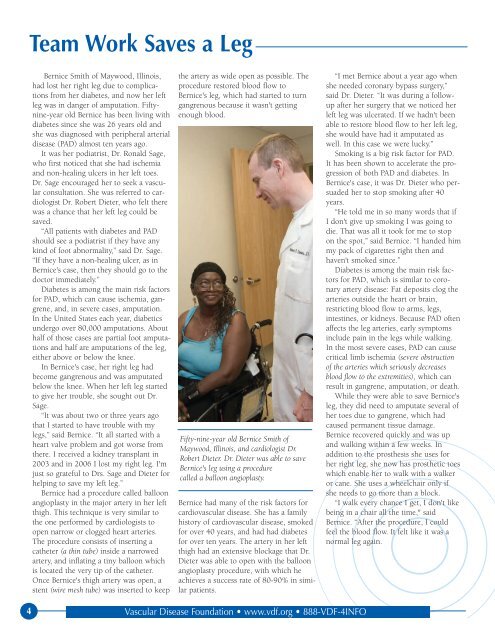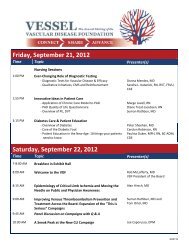V08-N04 - Vascular Disease Foundation
V08-N04 - Vascular Disease Foundation
V08-N04 - Vascular Disease Foundation
You also want an ePaper? Increase the reach of your titles
YUMPU automatically turns print PDFs into web optimized ePapers that Google loves.
Team Work Saves a Leg<br />
Bernice Smith of Maywood, Illinois,<br />
had lost her right leg due to complications<br />
from her diabetes, and now her left<br />
leg was in danger of amputation. Fiftynine-year<br />
old Bernice has been living with<br />
diabetes since she was 26 years old and<br />
she was diagnosed with peripheral arterial<br />
disease (PAD) almost ten years ago.<br />
It was her podiatrist, Dr. Ronald Sage,<br />
who first noticed that she had ischemia<br />
and non-healing ulcers in her left toes.<br />
Dr. Sage encouraged her to seek a vascular<br />
consultation. She was referred to cardiologist<br />
Dr. Robert Dieter, who felt there<br />
was a chance that her left leg could be<br />
saved.<br />
“All patients with diabetes and PAD<br />
should see a podiatrist if they have any<br />
kind of foot abnormality,” said Dr. Sage.<br />
“If they have a non-healing ulcer, as in<br />
Bernice's case, then they should go to the<br />
doctor immediately.”<br />
Diabetes is among the main risk factors<br />
for PAD, which can cause ischemia, gangrene,<br />
and, in severe cases, amputation.<br />
In the United States each year, diabetics<br />
undergo over 80,000 amputations. About<br />
half of those cases are partial foot amputations<br />
and half are amputations of the leg,<br />
either above or below the knee.<br />
In Bernice's case, her right leg had<br />
become gangrenous and was amputated<br />
below the knee. When her left leg started<br />
to give her trouble, she sought out Dr.<br />
Sage.<br />
“It was about two or three years ago<br />
that I started to have trouble with my<br />
legs,” said Bernice. “It all started with a<br />
heart valve problem and got worse from<br />
there. I received a kidney transplant in<br />
2003 and in 2006 I lost my right leg. I'm<br />
just so grateful to Drs. Sage and Dieter for<br />
helping to save my left leg.”<br />
Bernice had a procedure called balloon<br />
angioplasty in the major artery in her left<br />
thigh. This technique is very similar to<br />
the one performed by cardiologists to<br />
open narrow or clogged heart arteries.<br />
The procedure consists of inserting a<br />
catheter (a thin tube) inside a narrowed<br />
artery, and inflating a tiny balloon which<br />
is located the very tip of the catheter.<br />
Once Bernice's thigh artery was open, a<br />
stent (wire mesh tube) was inserted to keep<br />
the artery as wide open as possible. The<br />
procedure restored blood flow to<br />
Bernice's leg, which had started to turn<br />
gangrenous because it wasn't getting<br />
enough blood.<br />
Fifty-nine-year old Bernice Smith of<br />
Maywood, Illinois, and cardiologist Dr.<br />
Robert Dieter. Dr. Dieter was able to save<br />
Bernice's leg using a procedure<br />
called a balloon angioplasty.<br />
Bernice had many of the risk factors for<br />
cardiovascular disease. She has a family<br />
history of cardiovascular disease, smoked<br />
for over 40 years, and had had diabetes<br />
for over ten years. The artery in her left<br />
thigh had an extensive blockage that Dr.<br />
Dieter was able to open with the balloon<br />
angioplasty procedure, with which he<br />
achieves a success rate of 80-90% in similar<br />
patients.<br />
“I met Bernice about a year ago when<br />
she needed coronary bypass surgery,”<br />
said Dr. Dieter. “It was during a followup<br />
after her surgery that we noticed her<br />
left leg was ulcerated. If we hadn't been<br />
able to restore blood flow to her left leg,<br />
she would have had it amputated as<br />
well. In this case we were lucky.”<br />
Smoking is a big risk factor for PAD.<br />
It has been shown to accelerate the progression<br />
of both PAD and diabetes. In<br />
Bernice's case, it was Dr. Dieter who persuaded<br />
her to stop smoking after 40<br />
years.<br />
“He told me in so many words that if<br />
I don't give up smoking I was going to<br />
die. That was all it took for me to stop<br />
on the spot,” said Bernice. “I handed him<br />
my pack of cigarettes right then and<br />
haven't smoked since.”<br />
Diabetes is among the main risk factors<br />
for PAD, which is similar to coronary<br />
artery disease: Fat deposits clog the<br />
arteries outside the heart or brain,<br />
restricting blood flow to arms, legs,<br />
intestines, or kidneys. Because PAD often<br />
affects the leg arteries, early symptoms<br />
include pain in the legs while walking.<br />
In the most severe cases, PAD can cause<br />
critical limb ischemia (severe obstruction<br />
of the arteries which seriously decreases<br />
blood flow to the extremities), which can<br />
result in gangrene, amputation, or death.<br />
While they were able to save Bernice's<br />
leg, they did need to amputate several of<br />
her toes due to gangrene, which had<br />
caused permanent tissue damage.<br />
Bernice recovered quickly and was up<br />
and walking within a few weeks. In<br />
addition to the prosthesis she uses for<br />
her right leg, she now has prosthetic toes<br />
which enable her to walk with a walker<br />
or cane. She uses a wheelchair only if<br />
she needs to go more than a block.<br />
“I walk every chance I get, I don't like<br />
being in a chair all the time," said<br />
Bernice. “After the procedure, I could<br />
feel the blood flow. It felt like it was a<br />
normal leg again.<br />
4<br />
<strong>Vascular</strong> <strong>Disease</strong> <strong>Foundation</strong> • www.vdf.org • 888-VDF-4INFO







